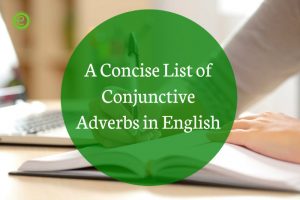In this lesson we will be helping you to learn about conjunctive adverbs, Before learning and knowing the application of conjunctive adverbs, you will have to be very clear with the meaning and usage of conjunctions.
Some words in the English grammar that are used as a joiner – that would connect different parts of a sentence.
Similarly, conjunctive adverbs for example, however, nevertheless and consequently are generated from the use of the complex relationship between ideas. You will understand coherence as the extension of conjunctive adverbs which are categorized according to the various uses and application in sentences.
Relation Between Conjunctive Adverbs and Conjunctions
After this basic understanding, you will be needing some in-depth knowledge of the things and how they take place in English grammar. You will be finding a list of conjunctive adverbs that will help you to weave a proper sentence in your own writing. The vital role of conjunctive adverbs is to connect. Just like conjunctions link two different independent or dependent clauses together and provide a smooth transition between ideas.
We already know that adverbs are the words in English grammar that have the potential to modify the verbs adjectives and other adverbs. Along with that, they can be used as conjunctions as well. Therefore they are known as conjunctive adverbs.
Conjunctive Adverb : Definition and Example Sentences
Now, we will be knowing the functions of conjunctive to provide ease in the transition between the ideas of two different sentences. This simple thing can be accomplished with the help of comparison, contrast, sequence, cause-effect or other relationship between ideas.
You will get an idea that when conjunctive adverbs are used to join the main clauses or sentences then it will act as a coordinating conjunction which generally connects two separate and complete ideas. When you connect two different clauses you will be using s semicolon and not a comma.
For instance in this example we will see the usage of Conjunctive adverbs.
- The heavy traffic on the main cross-made Maria think twice about stopping by the mall; moreover she had an exam next morning.
Some tips: When a conjunctive adverb is used in the beginning of the sentence then you must use a comma immediately after after the word.
- Mohana was really tired after a tough day a work. Therefore, she decided to take nap when she gets home.
In the above sentence you can see that the flow of the sentence is a bit weak so the comma is not necessary here.
- Sheena dropped her phone in the swimming pool, therefore she will be working extra hours to earn some more bucks to get a new phone.
- Little George got a poor grade in the mid term exam but he was determinant to get ‘A’ in the class.
A Concise List Of Commonly Used Conjunctive Adverbs
Accordingly | Also |
Anyhow | Besides |
Consequently | Conversely |
Finally | Furthermore |
Hence | However |
Indeed | Instead |
Likewise | Meanwhile |
Moreover | Nevertheless |
Next | Otherwise |
Similarly | Still |
Subsequently | Then |
Therefore | Thus |
With the table, you can make out that now you have a solid list of conjunctive adverbs to work with. You should be sure to punctuate around them properly. One thing that you must make sure is always using a semicolon at the end of the first independent clause. When you have all your conjunctive clauses in place, you can use the comma before entering into the second independent clause. With the comma, you could easily slice up the sentences and provide cohesion.
Conclusion:
In the end, we would like to discuss some points which will help you to make use of conjunctive adverbs in a better way. To study the use of such adverbs in deep, you can check out our other supporting blogs.
We at EnglishBix hope that this will help you to create in-depth and well-punctuated prose and sentences.


